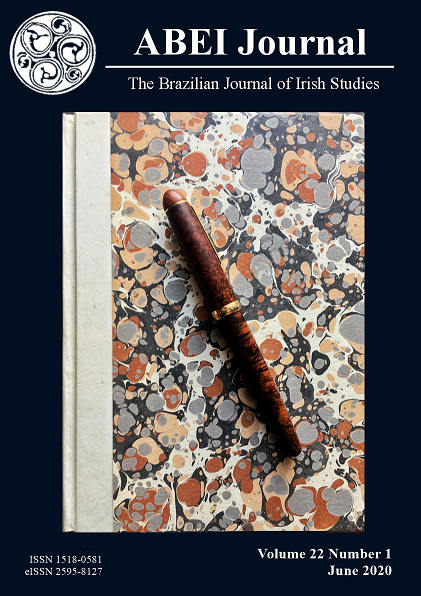“Cloud’s red, earth feeling, sky that thinks”: John Banville’s Aesth/ethics
DOI:
https://doi.org/10.37389/abei.v22i1.3857Keywords:
Stevens, Nietzsche, Deleuze, Husserl, Intentionality, Metacognition, Eternal recurrence, Becoming, Aesthetic, Hope, The Blue Guitar, Long LankinAbstract
John Banville’s long career can of course conventionally be viewed as a linearity, but it would be better seen as a form of spiral. This spiral is the hermeneutic process and concomitantly the movements of eternal recurrence in the oeuvre. In accordance with Nietzsche’s concept, these recurrences are not to be construed as returns of the identical. Rather, this ethic and aesthetic dimension in Banville is explicated as an attunement to the overall force of becoming. In agreement with Wallace Stevens’ poetics, Banville’s aesthetic is seen primarily as process. Through the immediate access to metacognition and reflection in the intentional act, Banville, through his protagonists, maintains a sense of wonder as hope in a fictional world often permeated by loss, melancholy and despair. This fictional trait is argued to have been there since the debut up to Banville’s more recent creative work.
References
Banville, John. The Blue Guitar. London: Penguin, 2016. [2015]
---. Long Lankin. Loughcrew: The Gallery Press, 1984. [1970]
---. Mefisto. London: Picador, 1999. [1986]
Cazeaux, Clive. Kant, Cognitive Metaphor and Continental Philosophy. London: Routledge, 2007.
DeForrest, Matthew. “W. B. Yeats’s A Vision: ‘Dove or Swan’”. W. B. Yeats’s A Vision: Explications and Contexts. Neil Mann, Matthew Gibson and Claire Nally. Eds. Liverpool University Press, 2012, pp. 136–58.
Deitz, Cody. “The Absent Center: Poetic Difficulty in Wallace Stevens’s ‘The Man with the Blue Guitar XXII.’” Explicator, vol. 75, no. 3, 2017, pp. 157–159.
Deleuze, Gilles. In Friedrich Nietzsche, Basic Writings of Nietzsche, Translated and edited by Walter Kaufmann. New York: Modern Library, 2000, pp. 857–60.
Heidegger, Martin. “The Word of Nietzsche: ‘God Is Dead’”. The Question Concerning Technology and Other Essays. New York: Harper & Row, 1977, pp. 53–112.
Henry, Michel. Material Phenomenology. 1st ed. New York: Fordham University Press, 2008.
Husserl, Edmund. The Idea of Phenomenology. Translated by Lee Hardy. Dordrecht: Kluwer, 1999.
Imhof, Rüdiger. John Banville: A Critical Introduction. Dublin: Wolfhound Press, 1997.
Ingarden, Roman. The Literary Work of Art. Chicago: Northwestern University Press, 1974.
Kenny, John. John Banville. Dublin: Irish Academic Press, 2009.
May, Todd. “When Is a Deleuzian Becoming?” Continental Philosophy Review, vol. 36, no. 2, June 2003, pp. 139–153.
Miller, J. Hillis, The Linguistic Moment: From Wordsworth to Stevens. Princeton, N.J., Princeton Univ. Press, 1985
Murphy, Neil. John Banville. Bucknell University Press, 2018. ProQuest Ebook Central, http://ebookcentral.proquest.com/lib/sub/detail.action?docID=5376712.
Palazzolo, Pietra. “Afterlives of a Supreme Fiction: John Banville’s Dialogue With Wallace Stevens”. In John Banville and His Precursors, Stephen Butler, Pietra Palazzolo and Michael Springer (eds). London: Bloomsbury Academic, 2019, pp. 87–109.
Robin, Thierry. “Liars, Similes and Story-tellers in The Blue Guitar by John Banville”. History, Memory and Nostalgia in Literature and Culture. Ed. Regina Rudaityté. Cambridge: Cambridge Scholars Publishing, 2018.
Stevens, Wallace. “The Man with the Blue Guitar”. The Collected Poems of Wallace Stevens. New York: Vintage, 1990, pp.175–94.
Tarien, Kersti. “Trying to Catch Long Lankin by His Arms: The Evolution of John Banville’s Long Lankin”. Irish University Review, no. 2, 2001, p. 386.
The Holy Bible. 2001. English Standard Version. Harper Collins Publishers. Crossway Bibles. Print.
Wrethed, Joakim. “Mnemonic Air in John Banville’s Science Tetralogy”. Recovering Memory: Irish Representations of Past and Present. Hedda Friberg, Irene Gilsenan Nordin, and Lene Yding Pedersen. Eds. Cambridge Scholars Publishing, 2007: pp. 280–90.
Zuntini de Izarra, Laura P. Mirrors and Holographic Labyrinths: The Process of a “New” Aesthetic Synthesis in John Banville’s Work. San Francisco: International Scholars Publications, 1999.
Downloads
Published
Issue
Section
License
Copyright (c) 2020 Joakim Wrethed

This work is licensed under a Creative Commons Attribution-NonCommercial 4.0 International License.


